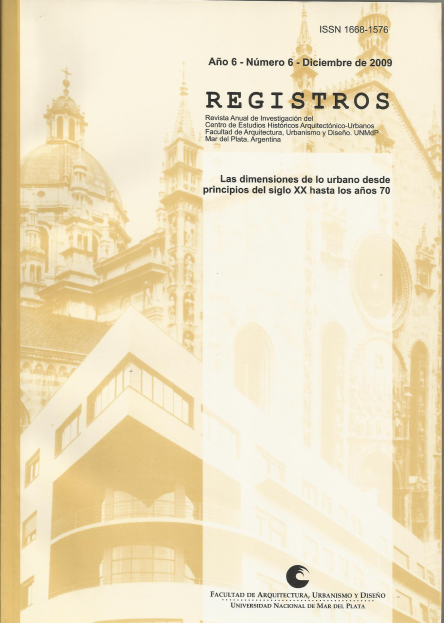The school in the city. Rosario in the 1930s
Keywords:
schools, public building, modern architecture, city, communitaryAbstract
The work explores the role of the primary school in the social and material transformation of
argentinian cities as Rosario in the 1930s. In these years the civic function is qualified with the communitary action due to the impact on the social dynamics of new collective identities constructed around neighborhoods in conformation from social ties linked to the place of residence and further enhanced by family and work routines including schooling. The school appears as a socialization machine in a context of social mobility and the emergence of the middle classes. Meanwhile, the provincial bureaucracies in shaping appeal to the modern public building as a means of legitimization.
When asked ¿why, and where primary schools were built? inquires into the expression of the urban meaning of the public-state, meaning that schools, like banners that ordered the cities functional and symbolically.
Downloads
References
CARUSO, Marcelo (2005). La biopolítica en las aulas: prácticas de conducción en las escuelas elementales del Reino de Baviera (1869-1919), Buenos Aires, Prometeo.
DOTTI, Jorge (1996). “La ambigüedad de lo público”, Punto de Vista, Buenos Aires, n. 54, p.: 27-32.
ESPINOZA, Lucía (2005). Arquitectura Escolar y Estado Moderno. Santa Fe 1900-1943, Santa Fe, Ediciones UNL.
FERNÁNDEZ, Sandra y ARMIDA, Marisa (2000). “Una ciudad en transición y crisis (1930-1943)”, en PLA, Alberto (coord.). Rosario en la Historia (de 1930 a nuestros días), Tomo I, Rosario, UNR Editora, p.: 23-151.
FOUCAULT, Michel (1975). Vigilar y castigar: nacimiento de la prisión, Buenos Aires, Siglo XXI, 2002.
GORELIK, Adrián (1998). La grilla y el parque. Espacio público y cultura urbana en Buenos Aires 1887-1936, Buenos Aires, Universidad Nacional de Quilmes.
GROPIUS, Walter (1949). “El planeamiento de vecindarios orgánicos”, Arquitectura y Planeamiento, Buenos Aires, Ediciones Infinito.
GUTIÉRREZ, Leandro y ROMERO, Luis Alberto (1995). Sectores populares, cultura y política, Buenos Aires, Sudamericana.
HALL, Peter (1990). Cities of Tomorrow, Gran Bretaña, Blackwell Publishers.
HARVEY, David (2000). “El nuevo urbanismo y la trampa comunitaria”, La Vanguardia, 26 de noviembre.
JACOBS, Jane (1967). Muerte y vida de las grandes ciudades, Madrid, Ediciones Península.
LIONETTI, Lucía (2007). La misión política de la escuela pública: educar al ciudadano de la república (1870-1916), Buenos Aires, Miño y Dávila.
MACOR, Darío (1993). La reforma política en la encrucijada. La experiencia demoprogresista en el Estado provincial santafesino, Santa Fe, Departamento de Extensión Universitaria UNL.
MÜLLER, Luis (inédito). Modernidades de provincia. Estado y arquitectura en la ciudad de Santa Fe (1935-1943).
MUMFORD, Lewis (1986). “The ideal form of the modern city”, en MILLER, Donald (ed.) The Lewis Mumford Reader, Atenas y Londres, University of Georgia Press.
OSZLAK, Oscar (1997). La formación del Estado argentino, Buenos Aires, Ariel Historia, 2006.
PERRY, Clarence (1929). "The Neighborhood Unit. A scheme of arrangement for the family-life community", Neigborhood and Community Planning. Regional Survey of New York and Its Environs, Regional Plan of New York and Its Environs, New York.
PLA, Alberto (2000). Rosario en la Historia (de 1930 a nuestros días), Tomo I, Rosario, UNR Editora.
PUIGGRÓS, Adriana (2001). Historia de la Educación Argentina IV. La educación en las Provincias y Territorios Nacionales (1885-1945), Buenos Aires, Galerna.
RAMA, Ángel (1984). La ciudad letrada. Montevideo, FIAR.
RIGOTTI, Ana María (en prensa). Las invenciones del Urbanismo en Argentina (1900 - 1960).
SCOBIE, James R. (1977). Buenos Aires. Del centro a los barrios. 1870-1910, Buenos Aires, Solar.
SENNETT, Richard (1974). Vida urbana e identidad personal, Barcelona, Península.
SENNETT, Richard (1978). El declive del hombre público, Barcelona, Península.
VIGO, J. M. (1971). “Luciano Molinas. El gobernador que cumplió”, Todo es Historia, Santa Fe, n. 54, p.: 9-27
Downloads
Published
How to Cite
Issue
Section
License
https://creativecommons.org/licenses/by/4.0/











